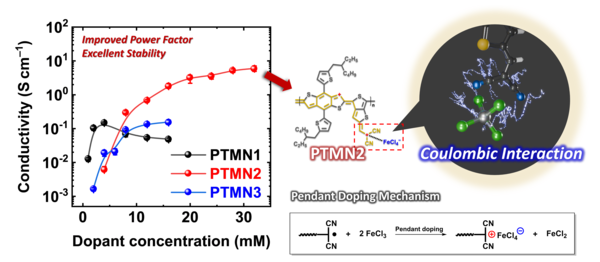Pendant-side doping strategy enhances structural stability, paving the way for wearable power sources

A joint research team led by Professor Jung In-hwan from the Department of Organic and Nano Engineering and Professor Jang Jae-young from the Department of Energy Engineering at Hanyang University has developed a new type of organic thermoelectric material capable of converting heat energy into electricity. The newly developed material is as light and flexible as fabric and offers excellent electrical conductivity, showing promise as a power source for wearable electronics that harvest electricity from body heat.
Thermoelectric materials are generally more efficient when they have low thermal conductivity and high electrical conductivity. While metals and alloys have traditionally been used, polymers have recently gained attention as organic thermoelectric materials due to their lightweight, flexibility, and low toxicity. However, polymers typically require strong doping to improve their low electrical conductivity. One commonly used dopant, ferric chloride (FeCl₃), can disrupt the polymer’s crystalline structure when applied in high concentrations, thereby reducing electrical performance.
To address this issue, the research team proposed a novel strategy to redirect the doping reaction from the polymer’s backbone to its pendant side chains.

The team synthesized three different polymers by co-polymerizing a newly designed electron-accepting monomer, which features special pendant side chains capable of forming conjugated structures, with electron-donating monomers of varying strengths.
The results showed that polymers with strong electron-donating units underwent doping reactions mainly along the backbone, which easily disrupted the crystalline structure. In contrast, polymers with weaker electron-donating units underwent pendant-side doping, which preserved the structure even at high doping levels and demonstrated superior thermoelectric performance.
This study experimentally confirmed that inducing a pendant doping mechanism is a promising new direction for developing high-performance organic thermoelectric materials.
Professor Jung In-hwan commented, “The polymer synthesis technology developed in this research is expected to be widely applied in the development of high-performance thermoelectric materials for powering wearable sensors and Internet of Things (IoT) devices.”
This research was supported by the Ministry of Science and ICT through the Nano and Materials Technology Development Program (Materials Global Young Connect and National Strategic Materials Development) and by the National Research Foundation of Korea (Basic Research Laboratory Program).
The findings were published on June 5 in Advanced Functional Materials, a leading journal in the field of materials science. The paper, titled “Distinctive Doping Behavior of Conjugated Polymers With Pendant-Side Conjugation for Enhanced Thermoelectric Properties,” lists Dr. Kim Hyuk-jun and doctoral student Kim Sang-beom as co–first authors, with doctoral candidate Pyo Seung-ok as a co-author, and Professors Jang Jae-young and Jung In-hwan as corresponding authors.
Click to see the paper:
https://advanced.onlinelibrary.wiley.com/doi/10.1002/adfm.202422778

 '한양위키' 키워드 보기
'한양위키' 키워드 보기